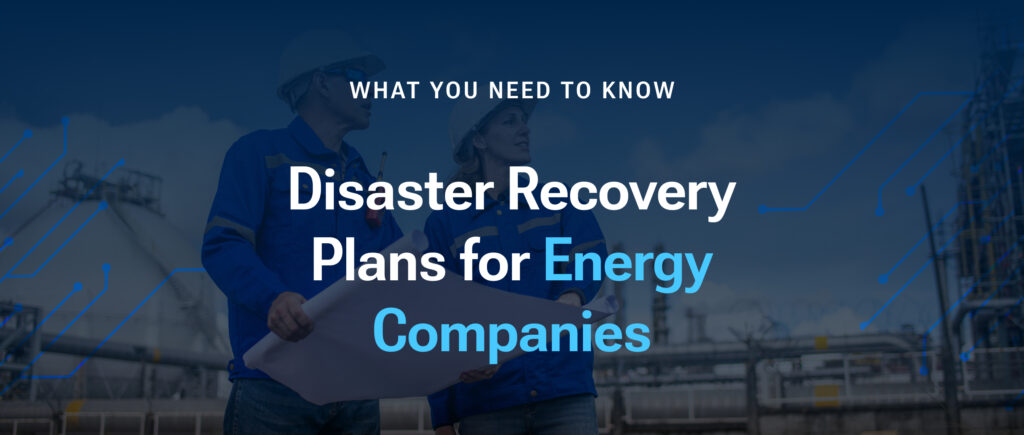In the energy industry, where operations run 24/7 and even minor disruptions can lead to massive financial losses, having a comprehensive disaster recovery plan (DRP) is critical. Natural disasters, cyberattacks, and hardware failures can strike at any moment, but with a well-structured plan in place, energy companies can safeguard their data and ensure minimal downtime. This blog explores the importance of disaster recovery plans for energy companies and how they can help protect critical systems and sensitive information.
Why Disaster Recovery Is Essential for Energy Companies
Energy companies operate some of the world’s most critical infrastructure. Whether you’re dealing with oil pipelines, electrical grids, or natural gas plants, the potential for disaster is ever-present. A solid disaster recovery plan not only helps maintain business continuity but also ensures data integrity and operational stability. Without one, energy companies could face long downtimes, legal penalties, and the loss of public trust.
From hurricanes that hit Gulf Coast oil refineries to ransomware attacks targeting electricity grids, these real-world examples show that disasters aren’t just a “what-if” scenario—they’re a reality.
1. Protecting Data with Managed IT Services
One of the best ways to ensure that your company is prepared for a disaster is by partnering with a managed IT service provider. Managed IT services offer proactive IT management solutions that help you implement and maintain a robust disaster recovery plan. They ensure continuous backups, manage servers, and provide email help if communication systems go down.
A managed IT service not only helps protect backup data but also works to ensure that your network infrastructure can be quickly restored. In the energy sector, where systems often involve complex networks, managed services are crucial for maintaining operational uptime and ensuring that critical systems are protected against cyberattacks and hardware failures.
For energy companies in Oklahoma City, Bethany, and Edmond, working with a local Managed IT Service provider can ensure that your business has the disaster recovery tools it needs to keep data safe and accessible.
2. The Role of Cloud Services in Disaster Recovery
Cloud services play an essential role in modern disaster recovery strategies. By storing data and applications offsite in the cloud, energy companies can avoid catastrophic data loss in the event of a local system failure or natural disaster. Additionally, cloud services offer scalability, meaning your disaster recovery solutions can grow with your company.
A reliable Cloud Service provider helps energy companies store mission-critical data securely and access it from anywhere, even during an emergency. This capability ensures that teams can continue working remotely, keeping operations moving while the primary systems are restored.
For energy companies in Midwest City and Warr Acres, cloud services also offer the added benefit of geographical redundancy—if one data center is compromised, another can take over, ensuring business continuity.
3. Network Security and Disaster Recovery: A Critical Combination
It’s no secret that energy companies are prime targets for cyberattacks. From state-sponsored attacks to ransomware targeting critical infrastructure, these threats can cripple operations. A disaster recovery plan must be paired with comprehensive network security protocols to minimize the risk of cyber incidents.
Effective Network Security systems defend your company against attacks while ensuring that your disaster recovery plan is always up to date. From firewalls and encryption to intrusion detection systems, the right network security framework ensures that when disaster strikes, your data remains safe, and your systems recover swiftly.
For companies in Nichols Hills, The Village, and Woodlawn Park, it’s essential to combine network security with disaster recovery planning to protect both physical assets and digital infrastructure.
4. Crafting a Tailored IT Plan for Disaster Recovery
A successful disaster recovery plan is not a one-size-fits-all solution. Every energy company has unique needs, especially when dealing with large-scale infrastructure. This is why it’s crucial to engage in IT planning and consult a virtual CIO (Chief Information Officer) to craft a tailored plan that suits your company’s specific requirements.
The IT Planning process should involve a comprehensive assessment of your current IT environment, pinpointing potential vulnerabilities, and designing a recovery solution that ensures fast recovery and minimal downtime. A virtual CIO can help guide energy companies through this process, providing expertise on how to integrate new technologies like cloud computing and backup solutions into their recovery plans.
5. Common Components of a Disaster Recovery Plan
While every disaster recovery plan is unique, energy companies should consider several key components when developing their strategy:
- Risk Assessment: Identify potential risks, from natural disasters to cyberattacks, that could disrupt your operations.
- Backup Data Solutions: Ensure that all critical data is regularly backed up, both on-site and in the cloud, to prevent loss in case of a disaster.
- Communication Plan: Develop a plan to maintain communication between key personnel, stakeholders, and customers during an emergency.
- Testing and Updates: Regularly test your disaster recovery plan and update it to reflect changes in technology and your company’s operational needs.
These elements help ensure that your company can quickly bounce back from any disruption and minimize the impact of disasters on your operations.
6. The Importance of Regular Testing and Updates
A disaster recovery plan is only effective if it works when you need it most. Regular testing ensures that your recovery plan is functional, up to date, and capable of handling the latest threats. Testing should include simulating potential disaster scenarios, like cyberattacks or physical damage to infrastructure, to ensure that all parts of the plan work as intended.
Energy companies in Oklahoma City, Edmond, and Nichols Hills can benefit from working with a managed IT service provider that offers ongoing monitoring and disaster recovery testing. By running regular drills, you can be confident that when disaster strikes, your company is prepared.
Conclusion: Protecting Your Energy Company with a Disaster Recovery Plan
Energy companies cannot afford to operate without a disaster recovery plan. The risks, ranging from natural disasters to cyberattacks, are too great, and the consequences of downtime can be devastating. By partnering with a managed IT service provider, incorporating cloud solutions, and focusing on network security, energy companies can ensure that their disaster recovery plans are robust and effective.
For companies in Oklahoma City and surrounding areas like Bethany, Midwest City, and Warr Acres, developing a tailored disaster recovery strategy is key to staying operational during emergencies. Ready to strengthen your disaster recovery plan? Contact Us today to see how we can help safeguard your energy business.
FAQs
1. Why is a disaster recovery plan essential for energy companies?
Energy companies handle critical infrastructure, and a disaster recovery plan ensures minimal downtime and protects data from being lost during disasters like cyberattacks or natural calamities.
2. How can managed IT services help with disaster recovery?
A managed IT service provider can manage your network, provide server help, and ensure regular backup data storage to make sure your disaster recovery plan is comprehensive and functional.
3. What role do cloud services play in disaster recovery?
Cloud services offer offsite data storage, ensuring data is secure and easily recoverable during a disaster. It allows for business continuity by keeping systems running from remote locations.
4. How often should disaster recovery plans be tested?
Regular testing, at least annually, is recommended to ensure that all elements of your disaster recovery plan function as expected and reflect current technology and risks.
5. How do disaster recovery plans support regulatory compliance in the energy industry?
A comprehensive disaster recovery plan helps energy companies stay compliant with industry regulations by ensuring data security, regular backups, and a clear recovery strategy.
6. Are there managed IT services for energy companies in Oklahoma City?
Yes, Managed IT Services in Oklahoma City offer customized disaster recovery solutions to protect energy companies from data loss and operational downtime.
7. How can energy companies in Bethany benefit from cloud services?
Energy companies in Bethany can utilize Cloud Services to store data securely offsite, ensuring data is safe and recoverable during an emergency.
8. What disaster recovery solutions are available for companies in Edmond?
In Edmond, companies can implement managed IT and network security solutions to protect their infrastructure from cyberattacks and ensure quick recovery in the event of a disaster.
9. How do energy companies in Midwest City protect their data?
Energy companies in Midwest City rely on backup data and disaster recovery plans to safeguard critical information and ensure business continuity during disasters.
10. Can disaster recovery plans support oil and gas companies in Nichols Hills?
Yes, disaster recovery plans, combined with robust network security, help oil and gas companies in Nichols Hills protect critical infrastructure from cyber threats and operational disruptions.
11. What managed IT services are available for The Village’s energy companies?
Energy companies in The Village can benefit from IT management and disaster recovery solutions to keep operations running smoothly, even in the face of a disaster.
12. How do disaster recovery plans protect energy companies in Woodlawn Park?
Energy companies in Woodlawn Park can safeguard their operations by implementing a disaster recovery plan that includes cloud services and proactive network security measures.

